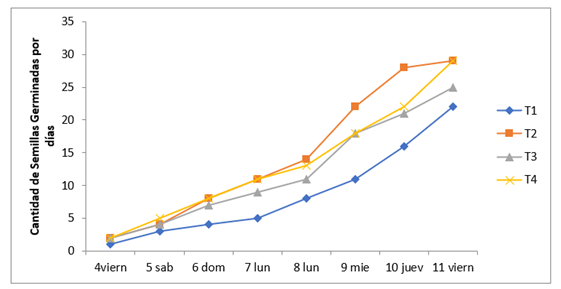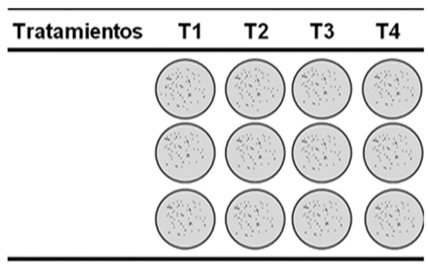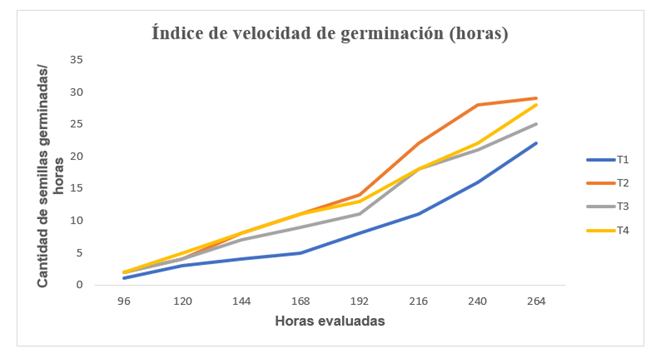Mi SciELO
Servicios Personalizados
Articulo
Indicadores
-
 Citado por SciELO
Citado por SciELO
Links relacionados
-
 Similares en
SciELO
Similares en
SciELO
Compartir
Revista Cubana de Ciencias Forestales
versión On-line ISSN 2310-3469
Rev CFORES vol.12 no.2 Pinar del Río mayo.-ago. 2024 Epub 02-Ago-2024
Original article
Influence of three pregerminative treatments in the germination of Ochroma seeds pyramidale (Cav. ex Lam.)
1Universidad Estatal Amazónica. Ecuador.
2Universidad de Pinar del Río "Hermanos Saíz Montes de Oca". Pinar del Río, Cuba.
The present study was carried out the Amazonian State University during the month of June, with the objective of evaluating the influence of three pregerminative treatments in the germination of Ochroma pyramidale (Cav. ex Lam.) seed. An experiment was established to determine the germination percentage and germination speed of O. pyramidale seeds. subjected to the following treatments: boiling the seed in water at a temperature of 100 0 C for 20 seconds, sanding the seeds until they lose their natural shine, immersion in 30% hydrochloric acid for 32 minutes and a control treatment. A completely randomized design was done where four treatments were set up with three replicates and 30 units to be observed, giving a total of 120 units observed. The germination percentage, germination speed index and germination dynamics were evaluated. The treatments T2 (boil in 100°C water for 20 seconds) and T4 (immersion in 30% hydrochloric acid for 32 minutes) were the ones with the best behavior, reaching a germination percentage of 97 and 96% respectively, reaching the maximum germination peaks starting eight days after the treatment was applied.
Key words: pregerminative treatments; germination; seed; germinative power.
INTRODUCTION
Tropical ecosystems host the greatest biological diversity on the planet in almost all forms of life, due to the geographical, environmental conditions and ecological complexity (Ríos et al., 2021). For this reason, the variety of plant and animal species that these ecosystems house favor the maintenance of life (Ríos et al., 2021).
At a global level, natural ecosystems are being threatened by anthropogenic extractive activities (Agus et al., 2020), such as deforestation, livestock, mining and human settlement, which imply change in land use (Agus et al., 2020). These activities generate landscape transformation, loss of ecosystem services and pollution (Patnaik, 2018). This problem arouses interest in the development of research focused on demonstrating the effects of economic activities on the environment and its components, as well as proposing management alternatives (Torres et al., 2018). A mitigation alternative has been and continues to be the recovery of ecosystems through forest species with restorative potential (Ríos et al., 2021).
However, there are species that have seeds with a hard cover, which makes it difficult to accelerate their germination, as occurs with O. pyramidale. The tree is native to the American tropics; It is frequently found in intervened and degraded areas (Jiménez et al., 2017). This species belongs to the Malvaceae family, it grows wild in the Amazon jungle, it is very commercial due to the high resistance and low density of its wood. The balsa is a tree with a warm and humid climate, which can grow to more than 30 meters with a diameter of D1.30 m of 40 centimeters or more (Doumet-Parraga et al., 2021).
O. pyramidale wood is very light which is suitable for making crafts, toys, insulating material, and airplane manufacturing; boats; hulls and decks of high-speed motorboats and is used in the blades of wind energy turbines in the People's Republic of China. Due to the great demand of the Asian country for the Ecuadorian raft, many of the forests have been affected, which is why it is necessary to reforest this species in areas where 90 % of the trees of this species have been extracted (Jiménez et al. 2017).
However, this species has a low germination capacity and so far in the bibliography consulted it is not confirmed that treatments are implemented to improve the germination percentage and the growth capacity of the species, understanding that the mechanisms that regulate the beginning of germination are under selective pressures , where there are seeds that, due to the physical and chemical characteristics of the seed coat, have a compact structure and consistency that is impermeable to water and gases, mechanically and chemically inhibiting germination (Ríos et al., 2021). The germination time of seeds also represents a problem for entities that seek to optimize their production in more accelerated cycles and periods of time; these characteristics limit their propagation (Serna-Mosquera et al., 2020).
Despite the multiple investigations that exist on the topic, information is still required on the variation in germination capacity in different treatments and under different environmental conditions (Toledo-González et al., 2019). Taking into account the above, the objective is proposed to evaluate the influence of three pregerminative treatments in the germination of Ochroma pyramidale seed.
MATERIALS AND METHODS
Description of the scenarios used in the research
The research took place in the facilities of the Experimental Center for Amazonian Research and Production (CEIPA) of the Amazonian State University, which is located in the province of Napo, in the Arosemena Tola canton, on the Puyo-Tena highway kilometer 44 and consists of an area of 2,848.20 ha, which is divided into primary forest (2000 ha-1), pastures (300 ha-1) and infrastructure (25 ha-1).
The CEIPA coordinates are the following:
Selection of experimental material
The origin of the seeds used for the research were obtained from the seed bank of the logging company Plantaciones de Balsa Plantabal SA, which were previously selected for the largest size and dimensions by using a metal mesh sieve, to extract the impurities, after this process they were submerged in a 250 mm beaker, in order to physically separate the good quality seeds by decanting and floating the infertile material and impurities.
Pregerminative treatments
Pregerminative treatments and a control were evaluated, boiling the seed in water at a temperature of 100 0 C for 20 seconds, sanding the seeds until they lose their natural shine, Immersion in 30 % hydrochloric acid for 32 minutes in the experiment, temperature values ranged between 20 -27 0 C and humidity 27 w were taken into account in a completely randomized design (Figure 1).
Treatment 1 (T1)- Control.
Treatment 2 (T2)- Boil in 100°C water for 20 seconds.
Treatment 3 (T3)- Sand the seeds until they lose their natural shine.
Treatment 4 (T4)- Immersion in 30% hydrochloric acid for 32 minutes.
In the experiment, a quantity of 10 seeds were evaluated per Petri dish with three replicates for each treatment, which gives a total of 120 seeds evaluated, coinciding with what was proposed by (Ríos et al., 2021), who carried out this same type of experiment with treatments. pregerminants in Ochroma pyramidale seeds.
In this experiment, the amount of germinated seeds was evaluated from 4-11 days after applying the treatments since in that period the highest percentage of germination (97%) of the seeds studied was reached, with which the percentage of germination and the germination speed index using the following formulas (Equation 1 and Equation 2).
RESULTS AND DISCUSSION
The germination percentage 11 days after applying the treatments shows higher means for treatments T2 and T4, which consisted of seeds boiled in water at 100°C for 20 seconds, immersion in 30% hydrochloric acid for 32 minutes with a value of 97 % and 96 % with respect to absolute control which reached a value of 73 %. 11 days has been considered as an evaluation criterion since it was when the highest germination values were reached (Figure 1).
Fig. 2. - Percentage of germinated seeds of Ochroma pyramidale 11 days after the treatments
The highest percentage (97 %) was observed in T2 (100°C water for 20 seconds). These values are higher than those reported by González et al. (2019), which observed among seven treatments, percentages between 62 and 69 % in treatments that included hot water (100°C) with different exposure times (three and ten seconds) being the highest percentages with statistically significant differences with respect to the other treatments evaluated. González et al. (2019) indicate that, although the germination percentages of O. pyramidale vary between 60 and 84 %, and can be affected by the quality of the seed. Other report like Jiménez et al. (2017) showed that at 80°C with exposure for three minutes, the percentage is 8.76 % and 19.14 % for seeds exposed to 100°C during 15 seconds. On the contrary, González et al. (2019) point out that at 100°C for three seconds the percentage is 64 %. Additionally, the impermeability of the cover, intrinsic factors such as water, gases, type of substrate and light can also have an influence on germination variations Jiménez et al. (2017). Consequently, González et al. (2019) confirm that boiling treatments facilitate the breaking of the seed coat as a result of the impact of temperature, which positively favors germination.
In Figure 3, the dynamics of germination from 4 days after applying the treatments shows a higher average for seeds treated with soaking in water at 100 °C for 20 seconds, immersion in 30 % hydrochloric acid for 32 minutes. compared to the absolute control which 11 days after starting the evaluations reached 73% germination (Figure 3).

Fig. 3. - Germination dynamics of Ochroma seeds pyramidale 4-11 days after the treatments are applied
Germination occurred on the fourth day after sowing in all treatments and control with some differences in the number of germinated seeds between treatments. These results are similar to those reported by Camacho et al., (2018), who report germination in all treatments four days after sowing, that coincides with Ríos et al. (2021), who evaluates several treatments (gibberellic acid 0, 100, 200 and 300mg L-1, and potassium nitrate 0.0.4, 0.8 and 1.2mg L-1, water at 80°C (0, 1, 2, and 3 minutes), and at 40° C (0, 24, 48 and 72 hours) obtaining 68 % germination through boiling treatments, this being the highest percentage obtained compared to the rest of the treatments.
In Figure 4, the germination speed index reached higher values in the treatments evaluated such as soaking in 100 °C water for 20 seconds, immersion in 30 % hydrochloric acid for 32 minutes. showing maximum peaks from 8 days after the evaluation began, compared to the control which shows them from 11 days onwards.
The germination speed was higher for treatments T2 and T4, which showed their maximum peaks from 192 h after application with maximum values of 14 and 13 respectively, which coincides with what was stated by Ríos et al. (2021) that soaked the seeds into hot water at 80°C until the seeds get cool (T1) and soaking them in 1 % HCl hydrochloric acid for 1 minute (T5). The seeds reached the highest germination speed and dispersion with 9 and 11 seeds respectively. In relation to the above (Morocho and Leiva, 2019) they found that in seeds treated with biostimulants the speed of germination and average germination time significantly increased compared to the control.
REFERENCIAS BIBLIOGRÁFICAS
AGUS, C., et al 2020. The effect of tropical peat land-use changes on plant diversity and soil properties. International Journal of Environmental Science and Technology, [en línea] vol. 17 no. 3, 1703-1712. Disponible en: https://doi.org/10.1007/ s13762-019-02579-x. [ Links ]
CAMACHO, R., ODELANTI, M., GARCIA, D., MERINO, P., & LOOR, W. 2018. Aceleración de la germinación de semillas de balsa (Ochroma pyramidale) por medio de métodos físicos y biológicos Acceleration. UTCiencias, [en línea]. vol. 5 no. 3, pp. 207-213. Disponible en: https://www.cabidigitallibrary.org/doi/full/10.5555/20219943977 [ Links ]
DOUMET-PARRAGA, ADIB SAMIR., RUIZ CEDEÑO, ANGÉLICA BEATRIZ., SÁNCHEZ- BRIONES, ARACELY. 2021. Cadena de valor del cultivo del árbol de balsa. Domingo de las Ciencias, [en línea] vol. 7 no. 3, pp. 539-551. DOI: https://doi.org/10.23857/dc.v7i3.1950 Disponible en: https://www.dominiodelasciencias.com/ojs/index.php/es/article/view/1950 [ Links ]
GONZÁLEZ, B., CERVANTES, X., TORRES, E., SÁNCHEZ, C., SIMBA, L. 2018. Caracterización del cultivo de balsa (Ochroma pyramidale) en la provincia de Los Ríos Ecuador. Revista Ciencia y Tecnología [en línea] vol. 3 no. 2 pp. 7-11. DOI: https://doi.org/10.18779/cyt.v3i2.94, Disponible en: https://revistas.uteq.edu.ec/index.php/cyt/article/view/94 [ Links ]
JIMÉNEZ, E., GARCÍAS, L., CARRANZA, M., CARRANZA, H., MORANTE, J., MARTÍNEZ, M., & CUÁSQUER, J. 2017. Germination and growth of Ochroma pyramidale (Cav. ex Lam.) Urb. in Ecuador. Scientia Agropecuaria, [en línea] vol. 8 no 3 243-250. Disponible en: https://doi.org/10.17268/sci.agropecu.2017.03.07 [ Links ]
MOROCHO, M., & LEIVA-MORA, M. 2019. Microorganismos eficientes, propiedades funcionales y aplicaciones agrícolas. Centro Agrícola, [en línea] vol. 46 no. 2, pp. 93-103. Disponible en: http://scielo.sld.cu/scielo.php?script=sci_arttext&pid=S0253-57852019000200093 [ Links ]
PATNAIK, R. 2018. Impact of Industrialization on Environment and Sustainable Solutions - Reflections from a South Indian Region. IOP Conference Series: Earth and Environmental Science, [en línea] vol. 120 no.1, pp. 08. Disponible en: https://doi.org/10.1088/1755-1315/120/1/012016. [ Links ]
RÍOS-GEOVO, V., CÓRDOBA-TOVAR, L., RAMÍREZ MOSQUERA, P. L., COPETE ARROYO, J. H., & RAMOS BARÓN, P. A. 2021. Métodos de escarificación química y sus efectos en la germinación de semillas de Ochroma pyramidale Cav. Ex Lam. Urb. Revista de Investigación Agraria y Ambiental [en línea] vol. 12 no 8, pp. 165-177. Disponible en: https://www.researchgate.net/publication/349018501_Metodos_de_escarificacion_quimica_y_sus_efectos_en_la_germinacion_de_semillas_de_Ochroma_pyramidale_Cav_ex_Lam_Urb. [ Links ]
SERNA-MOSQUERA, YESSIKA BIASNEY., TORRES-TORRES, JHON JERLEY., ASPRILLA-PALACIOS, YEISON YAIR. 2020. Durabilidad natural de la madera de Ochroma pyramidale Urb. en el municipio de Atrato, Colombia. Entramado, [en línea] vol. 16, no 1, p. 192-202. Disponible en: http://www.scielo.org.co/scielo.php?script=sci_arttext&pid=S1900-38032020000100192 [ Links ]
TOLEDO-GONZÁLEZ, K. A., LEVY-TACHER, S. I., MACARIO-MENDOZA, P. A., & DE NOVA-VÁZQUEZ, J. A. 2019. Germination of two varieties of Ochroma pyramidale (Cav. Ex Lam.) Urb. From the Lacandon Jungle, Chiapas. Revista Chapingo, Serie Ciencias Forestales y del Ambiente, [en línea] vol. 25 no. 1, pp. 85-94. Disponible en: https://doi.org/10.5154/r.rchscfa.2018.06.046 [ Links ]
TORRES, Y. P., CABALLERO-GALLARDO, K., & OLIVERO-VERBEL, J. 2018. Mercury pollution by gold mining in a global biodiversity hotspot, the Choco biogeographic region, Colombia. Chemosphere, [en línea] vol. 193, pp. 421-430. Disponible en: https://doi.org/10.1016/j.chemosphere.2017.10.160 [ Links ]
Received: February 18, 2024; Accepted: July 09, 2024











 texto en
texto en 




